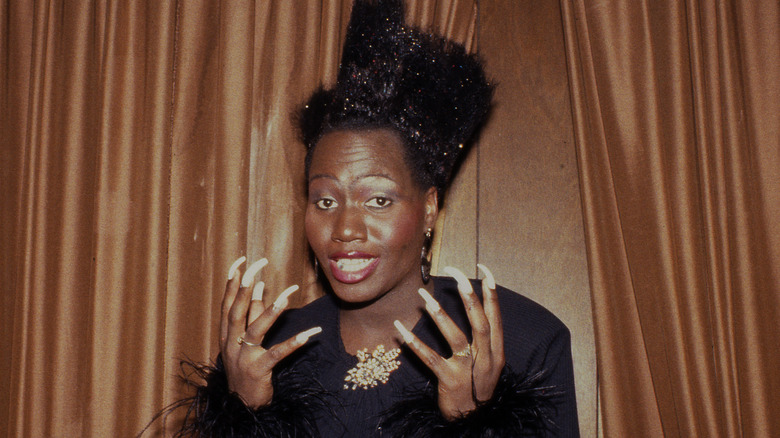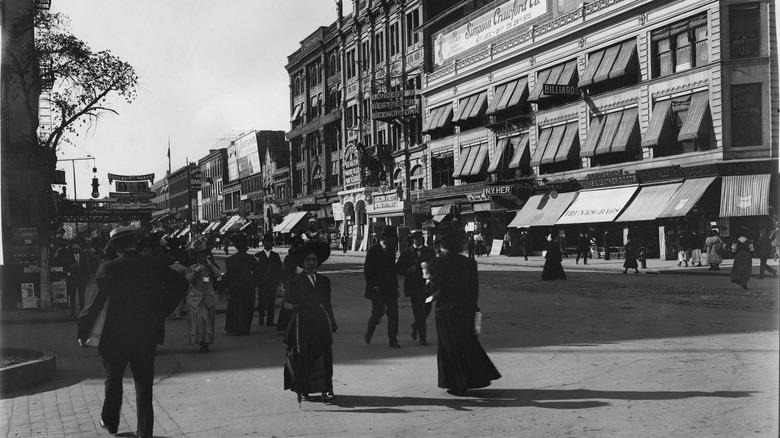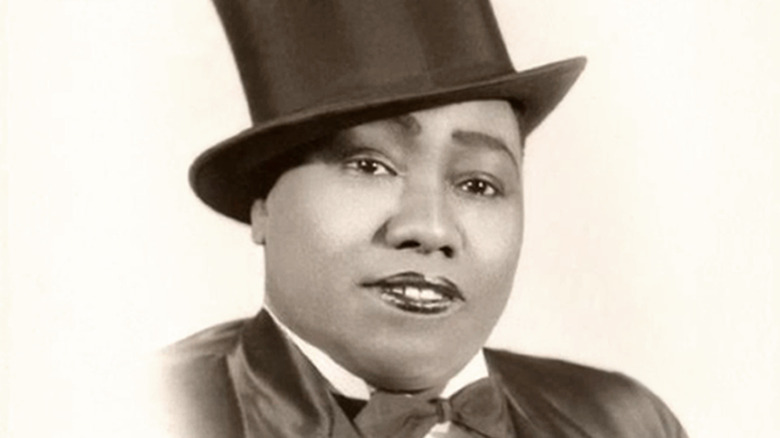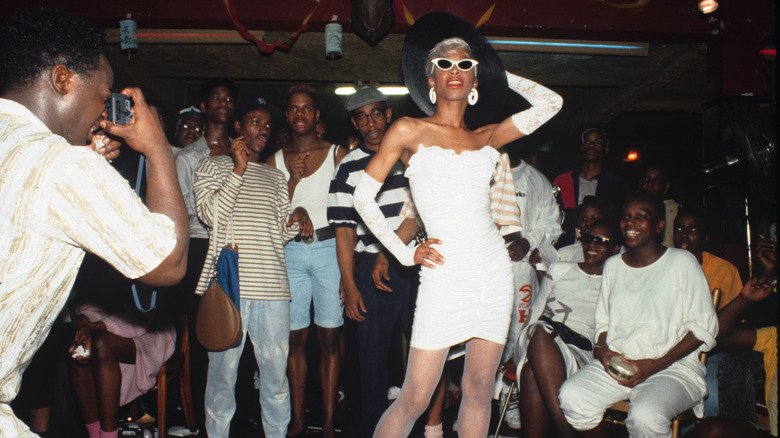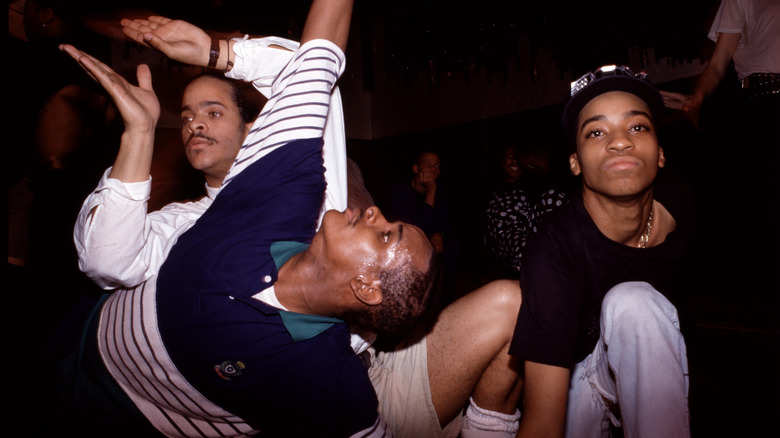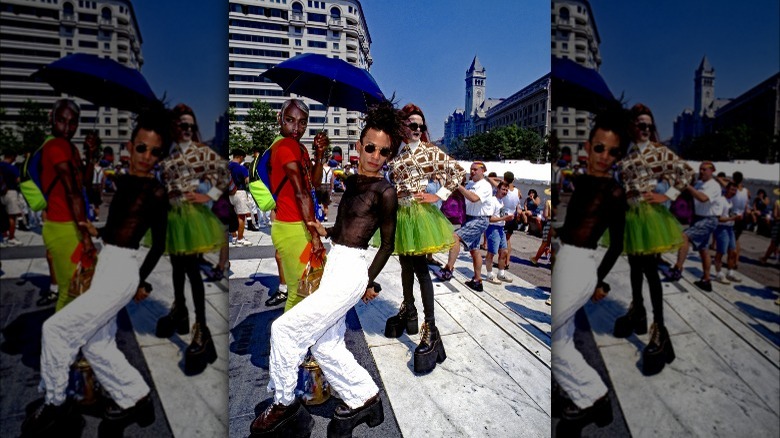Why The Harlem Ballroom Scene Was Important To The Black And Latinx LGBTQ+ Community
The Harlem Ballroom Scene can be thanked for common slang words like "shade" — to speak ill of something or someone –- or "werk," as in "werk it," or to do something well, according to Spectrum News NY1. Popular modern-day TV shows like "RuPaul's Drag Race" can also trace their roots to the New York movement. Meanwhile, Madonna's '90s-era smash hit song "Vogue" borrows its title and signature dance move from Harlem Ballroom. Most importantly, though, the Harlem Ballroom scene is a vital part of the gay rights struggle in New York and beyond, especially for the BIPOC (Black, Indigenous, and People of Color) community.
In the 19th century, "masquerade balls" were a place for queer Black and LatinX New Yorkers to be themselves when wearing clothing coded to the opposite gender was illegal in many places. That was especially true later in the 1920s, at a time now referred to as the Harlem Renaissance. During this prolific and creative period in Harlem, Black and Latinx voices flourished, influenced by LGBTQ+ culture.
As the masquerade ball scene evolved in the 20th century, what became known as Harlem Ballroom welcomed drag performers, gay, trans, and lesbian people of color. And with TV shows like 2018's "Pose" inspired by Harlem ballroom, among other examples, the scene remains relevant to this day (via The Independent).
The 19th-century masquerade balls
The Harlem Drag Balls of the 1980s, chronicled in the documentary film "Paris is Burning," can be traced to shortly after the American Civil War at venues like Harlem's Hamilton Lodge, among others, according to the National Museum of American History. Those events soon attracted members of the LGBTQ+ community in New York and Harlem, and almost just as quickly became targets of moral outrage.
Early on, similar events were organized by members of the heterosexual community, but they, too, offered the chance for LGBTQ+ performers to entertain members of mainstream society. According to historian Michael Henry Adams, at these 19th-century masquerade balls, "People were able to express their true identity, and in an audacious way, publicly, by making themselves and who they were into entertainment for heterosexual people to enjoy" (via Spectrum News NY1).
By 1916, masquerade balls were investigated by the Committee of Fourteen, dedicated to reforming what was, in their view, aberrant and amoral New York culture. In their extensive reporting, the committee referred to ball performers as "perverts," and called for the shows to end. There was a steep hill to climb toward acceptance, and similar barriers remain today.
The drag ball scene took on new meaning in the Harlem Renaissance
During the Harlem Renaissance, 19th century masquerade balls continued, as other elements of Black art and culture thrived in the period. Wearing clothing of the opposite sex was still illegal, and over time, the events became an increasingly — though not strictly — LGBTQ+ experience. As a result, Harlem became a capital of gay, lesbian, and transgender culture for people like Gladys Bentley, a female New York musician who wore men's clothing in this period, pictured above (via Smithsonian Magazine).
On the zenith of ballroom during the Harlem Renaissance, historian George Chauncy said these performances, "enhanced the solidarity of the gay world and symbolized the continuing centrality of gender inversion to gay culture," per the National Museum of American History. American poet Langston Hughes was known to attend, and their inclusive nature made sense: Many luminaries of the Harlem Renaissance were gay, as historian Michael Henry Adams points out.
"If you look at the greats of the Harlem Renaissance, be they singers or writers or artists, so many of them were gay," Adams said. Straight culture was involved, but all the while, "LGBTQ people felt comfortable attending as themselves with their lovers, boyfriends, and friends," Adams added (via Spectrum News NY1).
The rise of 'House Ballroom'
From the 1920s, the Harlem Ballroom Scene remained a centerpiece of American LGTBQ+ culture, and by the '60s and '70s, one of the movement's most distinctive characteristics evolved, known as "House Ballroom," History writes. By 1973, House Ballroom split somewhat from the Ballroom Scene tradition, developing a sound, look, dance, and performance style all its own (not to be confused with a style of electronic dance music known as "house," which developed primarily in Chicago in the '80s, according to Icon Collective).
The trans drag queen Crystal LaBeija was a central figure at this time, and crucial to House Ballroom was a family-like structure, according to Julian Kevon Glover assistant professor of gender, sexuality, and women's studies and dance and choreography at Virginia Commonwealth University (via History). "In ballroom, houses offer the primary infrastructure upon which the scene is built," Glover said.
That family hierarchy provided, "the basic kind of kinship structure, and also demonstrates alternative possibilities for what kinship can look like. Moving away from this reliance on one's biological family, and complicating ideas of a family of choice," Glover added. House Ballroom might feature traditional drag performances with beauty pageants and fashion shows, and both trans and queer male and female performers participated.
Madonna borrowed Vogue from House Ballroom
From the early Masquerade Balls in Harlem through the Harlem Renaissance and finally to the House Ballroom scene, music, dance, and fashion were always central, NME writes. As well as the social ground gained through this movement, one dance in particular called "vogue" or "voguing," became one of House Ballroom's most significant American cultural contributions, and in turn, House Ballroom music and dance is sometimes referred to as "ball" or just "vogue."
Early on, vogue was sometimes called "pop, dip and spin" a cousin of sorts to break dancing. Some now trace vogue to imprisoned gay, trans, and queer people at New York's Rikers Island, TIME reported in 2021. According to gender studies and dance assistant professor, Julian Kevon Glover, vogue was an act of resistance. "Voguing is very much about telling one's story through movement ... And that for me, because of who is doing it, is very much an act of resistance to an entire world that not only tells us that our lives are devoid of meaning, but also tells us that we have nothing to contribute. It's a kind of resistance, an embodied kind of resistance, to these cultural messages." he said, via History.
In 1990, Madonna brought "voguing" to the pop charts with her hit "Vogue" written and performed in the style of House Ballroom. With that, all across the world, people were dancing like they were in Harlem — though they may not have known it at the time.
The Harlem Ballroom Scene's legacy continues today
Harlem Ballroom's influence on popular culture can now be found everywhere, from Madonna's "Vogue" and the movie "Paris is Burning" to pop singer Rihanna's Ballroom inclusion at her Savage X Fenty fashion show, and even the language we use, The Village Voice reports. According to assistant professor Julian Kevon Glover, Ballroom culture's influence could be thought of as a whale.
"It primarily dwells deep, deep, deep in the ocean", Glover said (via History). "But there are moments when the scene comes up for air and emerges through the water, making a splash within the popular culture scene before returning to the oceans depths while those on the surface feel its ripples for quite some time," Glover added.
According to trans-rights activist Sydney Baloue, speaking with Spectrum News NY1, Ballroom created "this opening in a way, to celebrate yourself, to celebrate your culture, to celebrate who you are, and to be around your friends and be open and out and unapologetic. What really drew me to it is the fact that it was a community rooted in a black Latino experience of LGBTQ identity, and I really felt like I saw myself," Baloue added.
